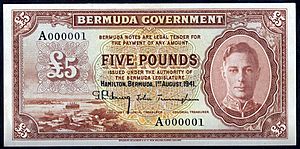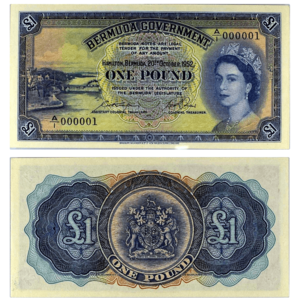Bermudian pound facts for kids
Quick facts for kids Bermudian pound |
|
|---|---|
| User(s) | Bermuda |
| Pegged with | sterling at par |
| Subunit | |
| 1⁄20 | shilling (s or /–) |
| 1⁄240 | penny (d) |
| Symbol | £ |
| Coins | 5/– |
| Banknotes | 5/–, 10/–, £1, £5, £10 |
The pound was the money used in Bermuda until 1970. It was just like the British pound. It was also divided the same way: 20 shillings made one pound, and each shilling had 12 pence.
In 1970, Bermuda changed its money system. They switched from the pound to the Bermudian dollar. One Bermudian dollar was worth 8 shillings and 4 pence (or 100 pence). This new dollar was equal in value to the US dollar.
Coins of Bermuda
The very first coins made for Bermuda were called "hogge money." These coins were made between 1612 and 1624. They came in values of 2d, 3d, 6d, and 1 shilling. They got their name because they had a picture of a pig on one side! At that time, Bermuda was also known as Somers Island, and this name appeared on the coins.
Later, in 1793, copper pennies were made. When Bermuda started using the British sterling system in the 1800s, they used the same coins as the United Kingdom. Bermuda didn't make its own regular coins for everyday use.
However, special silver crowns (worth five shillings) were made in 1959 and 1964. These were collector's coins, not for daily spending. They looked like British crowns but had Bermudian designs. The 1959 coin showed a map of the islands. This was to celebrate 350 years since Bermuda was settled. The 1964 coin featured Bermuda's coat of arms.
Bermuda's Banknotes
In 1914, the government of Bermuda started printing its own paper money. The first notes were worth £1. In 1920, they added 5-shilling notes. Then, 10-shilling notes came out in 1927, and £5 notes in 1941. The 5-shilling note stopped being made in 1957. Finally, £10 notes were introduced in 1964.
A History of Money in Bermuda
For almost 400 years, Spanish dollars were very common on trade routes, including around the Caribbean Sea. These silver coins were also known as pieces of eight. But after wars in Latin America, fewer of these silver coins were made. The last Spanish dollar was minted in 1825.
The United Kingdom had a strong money system based on gold since 1821. So, in 1825, they decided to introduce British sterling coins to all their colonies. A special law was passed to make British coins legal money in the colonies. It said that one Spanish dollar was worth 4 shillings and 4 pence sterling.
However, this exchange rate didn't quite work. It actually made British coins less popular in many colonies. So, in 1838, a new law changed the rate to one dollar being worth 4 shillings and 2 pence.
In some places like Jamaica, British Honduras, Bermuda, and later the Bahamas, people used a different system. They called a British shilling a 'Maccaroni' and treated it as one quarter of a dollar. This system helped British coins and money accounts become popular there.
On January 1, 1842, Bermuda officially made sterling its main currency. It was used alongside Doubloons (gold coins worth 64 shillings). Unlike the Bahamas, Bermuda did not start using US dollars. Spanish dollars became less common in the 1850s. But they returned in the 1870s after a global silver crisis.
In 1874, Bermuda's merchants decided not to accept many US dollars unless they were sold at a big discount. So, the US dollars were sent away. In 1876, a law was passed to stop using silver dollars as money.
In 1882, another local law stopped the gold doubloon from being legal money. This left sterling as the only official currency in Bermuda. Sterling remained Bermuda's money until 1970.
The British pound became less important as a world currency, and the US dollar became more important. Because of this, Bermuda introduced a new dollar-based currency. This new Bermuda dollar was set to be equal in value to the US dollar. This change happened in 1970, ending the old pound, shilling, and pence system in Bermuda. This was even before the United Kingdom itself changed its money system.
Bermuda decided to link its money to the US dollar partly because the British pound lost some value in 1967. Also, Bermuda was starting to keep more of its money in US dollars. Even though Bermuda switched to a US dollar-based currency, it was still part of the sterling area for a while. This was because the British pound and the US dollar had a fixed exchange rate at that time.
In 1971, the US dollar had a crisis, which ended the international Bretton Woods agreement. The US dollar lost some value, but the Bermuda dollar stayed linked to the British pound. Then, on June 22, 1972, the United Kingdom stopped its exchange control laws. This meant Bermuda was no longer part of the special sterling area.
Bermuda reacted quickly on June 30, 1972. They changed their own exchange control laws. At the same time, Bermuda made its dollar equal to the US dollar again. It was officially linked to the US dollar at a one-to-one rate. As far as British law was concerned, Bermuda was still part of the overseas sterling area until all exchange controls were removed in 1979.



